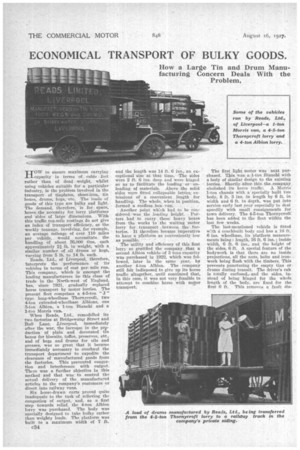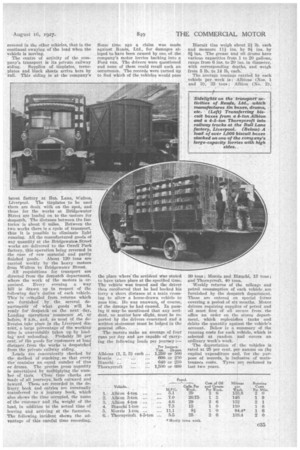ECONOMICAL TRANSPORT OF BULKY GOODS.
Page 56

Page 57

If you've noticed an error in this article please click here to report it so we can fix it.
How a Large Tin and Drum Manufactuy ing Concern Deals With the Problem.
JJow to ensure maximum carrying -L-1-capacity in terms of cubic feet rather than of dead weight, whilst using vehicles suitable for a particular • industry, is the problem involved in the transport of tinplates, sheet-iron, tin boxes, drums, kegs, etc. The loads of goods of this type are bulky and light. The demand, therefore, is for • space, hence the necessity for lorry platforms and sides of large dimensions. With this traffic ton-mile coatings do not give an index of transport efficiency, as the weekly tonnage, involving, for example, an average mileage of over. 110 miles per vehicle, . would necessitate the handling of about 36,000 tins, each approximately 21 lb. in weight, with a similar number of oil drums or kegs, varying from 5 lb. to 14 lb. each.
Reads, Ltd., of Liverpool, therefore, Interprets the performance of its
vehicles in terms of cost per mile run. This company, whiels is amongst the: leading manufacturers ire this class of trade in the North-west of England, has, since 1921, gradually replaced horse transport by motor lorries. The present fleet comprises a 4-5-ton " J " type long-wheelbase Thornycroft, two 4-ton extended-wheelbase Albions, one 3-ton Albion, a 1-ton Bianchi and a 1-ton Morris vans
'When Reads, Ltd., remodelled its two factories at Bridgewater Street and Bull Lane, Liverpool, immediately after the war, the increase in the production of plain and decorated tin boxes for biscuits, toffee, preserves, etc., and of kegs and drums for oils and greases, was so great that it became immediately necessary to overhaul the transport department to expedite the clearance of manufactured goods from the factories. This prevented congestion and interference with output. There was a further objective in this method and that was to control the actual delivery of the manufactured articles to the company's customers or direct into railway vans.
Six horse-drawn carts proved quite inadequate to the task of relieving the congestion of output, and, as a first step towards relief, the 4-ton Albion lorry was purchased. The body was specially designed to take bulky rather than weighty loads. The platform was built to a maximum width of 7 ft. and the length was 14 ft. 6 ins., an exceptional size at that time. The sides were 2 ft. 6 ins, deep and were hinged so as to facilitate the loading or unloading of materials. Above the solid sides were fitted collapsable lattice extensions of a convenient, length for handling. The whole, when in position, formeda roofless box van: Another point which had to be considered was the loading height. Por ters, had to carry, heavy boxes from the works to the waiting motor lorry for transport between the factories. It therefore became imperative to have a pratform as conveniently low as possible. • . The utility and efficiency of this first lorry so gratified the company that a second Albion vehicle of 3 tons capacity was purchased in 1922, which was followed, later in the saline year, by another 4-ton Albion. The company still felt indisposed to give up its horse traffic altogether, until convinced that, in this case, it was not very feasible to attempt to combine horse with motor transport.
The first light motor was next purchased. T‘his was a 1-ton Bianchi with a body of similar design to the existing lorries. Shortly after. this the company abolished its horre traffic. A Morris 1-ton chassis with a specially built van body, 8 ft. 3 ins. in length by 6 ft. in width and 6 ft. in depth, was put into service early last year especially to deal speedily with small consignments for town delivery. The 4-5-ton Thornycroft' has been added to the fleet within the last few weeks.
The last-mentioned vehicle is fitted with a coachbuilt body and has a 16 ft. 6 ins, wheelbase, its platform measurements being : length, 16 ft. 6 ins. ; inside width, 6 ft. 6 ins., and the height of the sides, 6 ft. A special feature of the bodywork is that there are no inside projections, all the nuts, bolts and ironwork being flush with the timbers. This prevents puncturing the empty tins or drums during transit. The driver's cab is totally enclosed. and the sides, instead of being hinged for the whole length of the body, are fixed for the first 6 ft. This removes a fault dis covered in the other vehicles, that is the continual swaying of the load when the vehicle is moving, The centre of activity of the company's transport is its private railway
siding. Supplies of tinplates, terneplates and black sheets arrive here by -rail. This siding is at the company's
latest factory at BuI.. Lane; Walton, Liverpool. The tinplates to be used there are dealt with on the .spot, and those for the works at Bridgewater Street are loaded on to the motors for despatch. The distance between the factories is about 6 miles. Between the two works there is a cycle of transport, thus it is possible to eliminate light running. All the manufactured goods of any quantity at the Bridgewater:Street works are delivered to the Orrell Park factory, this operation being reversed in the case of raw material and partly finished goods. About 120 tons are carried weekly by the heavy motors from Walton to Bridgewater Street.
All requisitions for transport are directed from the despatch department, where the work of the motors is • organised. Every evening a way bill is drawn up in respect of the following day's duties of each vehicle. Thisis colhpiled from returns which are furnished by the several departmentS of What goods will ,be
. .
ready for despatch' on' the next day. Loading operations commence ,at, or before, 8:a.m. and, as most of the 4eliveries,take placie it the Liverpool distriet, a large percentage of the working time is unavoidably taken up by loading andunloading. , Probably 30 per cent: .of the goads for customers at long distance, from the works is despatched from the private railway, siding.
Loads are conveniently checked by the Method, of stacking, so that every. tier contains an equal number of tins or drums. The precise gross quantity is ascertained by Multiplying the num-, ter of. tiers. Closetime checks are Made of all.journeys, both.olitward and inward. These are recorded in the delivery book and entries are eventually transferred to a journey book, which also shows the time occupied, the name of the customer and the weight of theload, in addition to the actual time of leaving and arriving at the factories. The following incident shows the advantage of this careful time recording.
Some time ago a claim was made against Reads, Ltd., for damages alleged to have been caused by one, of the company's motor lorries backing into a Ford van. The drivers were questioned and none of them could recall such an occurrence. The records were turned up to find which of the vehicles would pass the place where'the accident Was stated to have taken place at the specified time. The vehicle was traced and the driver then recollected that he had backed his lorry a short distance at a main crossing to allow a horse-drawn vehicle to pass him. He was unaware, of course, of the damage be had caused. In passing it may be mentioned that any accident, no matter how slight, must be reported by the drivers concerned and a written statement must be lodged in the general office.
The motors make an average of four runs per day and are capable of carrying the following loads per journey :— Per journey.
Albions (J., 2, 3) each ... Morris ... Bianchi ... Thornycroft 1,250 or 500 600 Or 230 640 or 230 1,500 or 600
Biscuit tins weigh about 2f lb. each and measure lif ins. by 9* ins, by si ins. The grease and oil drums have various capacities from 1 to 20 gallons, range from 6 ins. to 20 ins, in diameter, with corresponding depths, and weigh from 5 lb. to 14 1/;', each:
The average tonnage carried by each vehicle per week is : Albions (Nos. 1 and 3), 32 tons ; Albion (No. 2), 30 tons ; Morris and Bianchi, 13 tons ; and Thornycroft, 40 tons.
Weekly returns of the mileage and petrol consumption of each vehicle, are furnished by the despatch department. These are entered on special forms covering a period of six months. Motor drivers requiring supplies of petrol and • oil must first of all secure from the office an order on the stores department, which replenishes tanks and debits the quantity against the vehicle's account. Below is a summary of the running costs for each vehicle, which is selected at random nd covers an ordinary week's work.
The depreciation of the vehicles is rated at 25 per cent. pr annum on the capital expenditure an , for the purpose of records, is in lusive of maintenance costs. Tyres are reckoned to last two years.












































































































